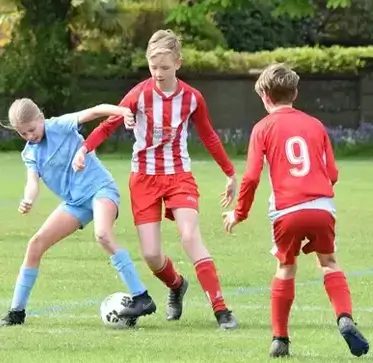How to Become a Good Soccer Defender: What Every Defender in Soccer Should Work On

CRFC BLOGS
LATEST BLOGS & NEWSLETTERS
How to Become a Good Soccer Defender: What Every Defender in Soccer Should Work On
Every soccer team needs a solid defender — someone who protects the goal, reads the game, and leads under pressure. Whether you’re a parent, coach, or young soccer player, knowing what a soccer defender should work on can make a major difference. This guide breaks down the key skills every defender in soccer needs, from 1v1 defending to mental toughness.
1. Understanding the Role of a Soccer Defender
A great soccer defender is more than just a player who tackles. They read the game, support teammates, and build play from the back.
- Prevent strikers and wingers from scoring
- Communicate with the goalkeeper and midfielders
- Win 1v1 battles and make smart decisions
Key takeaway: A reliable defender brings discipline, awareness, and confidence to every position.
2. Positioning: The Foundation of a Good Defender
Great defenders don’t chase the ball — they position themselves to intercept passes and reduce space for attackers.
Focus on:
- Staying goal-side and between the ball and the net
- Anticipating movement from forwards
- Holding the defensive line to catch players offside
Tip: Good positioning beats raw speed every time.
3. Mastering 1v1 Defending Skills
In youth soccer, most defensive mistakes happen in 1v1 situations. Smart 1v1 defending is about control, not diving in.
Train with:
- Side-on stance and small steps
- Patience — force the attacker wide
- Timed challenges when the dribble is too far
Key takeaway: 1v1 control gives defenders the upper hand without fouling.

4. Tackling with Timing and Discipline
A mistimed tackle can lead to a dangerous foul. Good defenders tackle only when there’s a clear chance to win the ball.
Improve tackling by:
- Practicing foot placement and body control
- Timing your step when the attacker loses control
- Avoiding risky lunges near the box
Tip: Smart defenders know when to delay and when to tackle.
5. Defending Against Wingers and Wide Forwards
Full-backs and wing-backs must defend fast, tricky players like wingers and overlapping midfielders.
Focus on:
- Jockeying to the sideline — reduce space
- Reading body movement before the cross
- Supporting the center backs when under pressure
Key takeaway: Wide defenders must be agile, alert, and hard to beat in space.
6. Passing Under Pressure as a Soccer Defender
Modern soccer defenders start attacks. Composed passing prevents turnovers and creates chances.
Work on:
- Passing to midfielders and wide players in space
- Short, firm passes with both feet
- Staying calm with pressure from forwards
Tip: A defender who passes confidently builds trust across the field.

7. Clearing Danger the Right Way
Sometimes, the safest play is a simple one. Effective defenders know when to clear and when to hold.
Drill these:
- Clearing under pressure with both feet
- Using headers to clear crosses and set pieces
- Making decisions quickly in high-stakes moments
Key takeaway: If you’re unsure — clear it. Safety first.
8. Communication: Be the Voice of the Backline
Soccer defenders can see the whole field. Vocal leadership organizes the team and avoids confusion.
Practice:
- Calling out “Man on!”, “Step up!”, “Switch!” during games
- Giving instructions during set pieces
- Keeping tone confident and clear
Tip: The best defenders talk — a lot.
9. Defensive Heading and Aerial Control
A powerful, well-timed header can prevent goals and win balls in the air.
Train by:
- Timing jumps to meet the ball at its highest point
- Directing headers upfield or out wide
- Staying brave in crowded areas
Key takeaway: Air dominance is key for any central defender.

10. Recovery Runs and Chasing Back
Even the best defender will get beaten sometimes. How you recover makes all the difference.
To improve:
- Sprint at the right angle, not just in a straight line
- Focus on the ball and player movement
- Know when to safely commit a foul to stop play
Tip: Recovery speed is critical for shutting down breaks.
11. Mental Focus and Style of Play
A good soccer defender must stay alert from kickoff to final whistle. Mental strength sets elite players apart.
Build this by:
- Staying locked in during quiet moments
- Learning your team’s style of play
- Reflecting after games — what went well, what didn’t
Key takeaway: Mentally tough defenders don’t get rattled by mistakes or pressure.

Conclusion: How to Train a Complete Soccer Defender
Becoming a complete defender in soccer takes more than size or speed. Youth soccer players can improve by working on:
- 1v1 defending and positioning
- Tackling with timing
- Communication and heading
- Passing under pressure
- Mental and physical discipline
Start early. Focus on fundamentals. And build confidence through repetition.
Need Help Training Your Young Soccer Defender?
At Charlotte Rise FC, our camps and development programs help players grow into confident, smart defenders. Whether your child plays full-back, center-back, or wing-back, we help them master the skills to shine.
Explore our youth soccer programs across Charlotte, Matthews, and Waxhaw to support your child’s development as a reliable soccer defender.
Frequently Asked Questions About Soccer Defenders
What should a soccer defender work on the most?
A defender should focus on positioning, 1v1 defending, and calm passing under pressure. These are the foundation of every strong backline.
How do I teach my child to tackle safely in soccer?
Use drills that emphasize patience and timing. Focus on containment first, then teach how to time the tackle when the attacker loses control.
How do defenders handle fast attackers or tricky wingers?
They must rely on good positioning, patience, and recovery runs. Wing-backs especially must be quick and disciplined against pacey wingers.
How do I know if my child is suited for the defender position?
If your child is strong in focus, calm under pressure, and enjoys stopping goals rather than scoring them, the defender position may be a perfect fit.

Did you find this useful?


